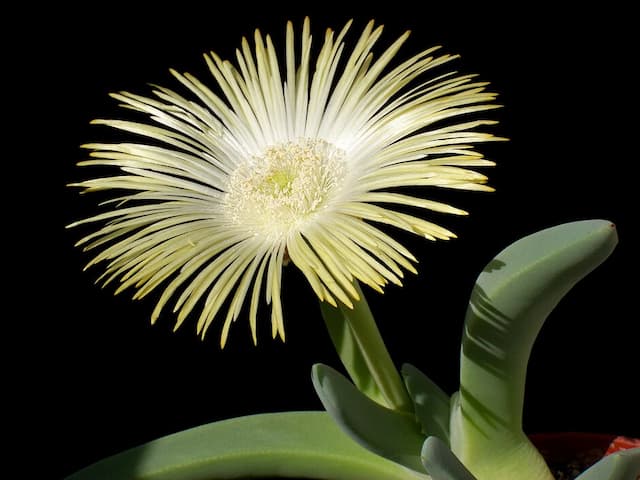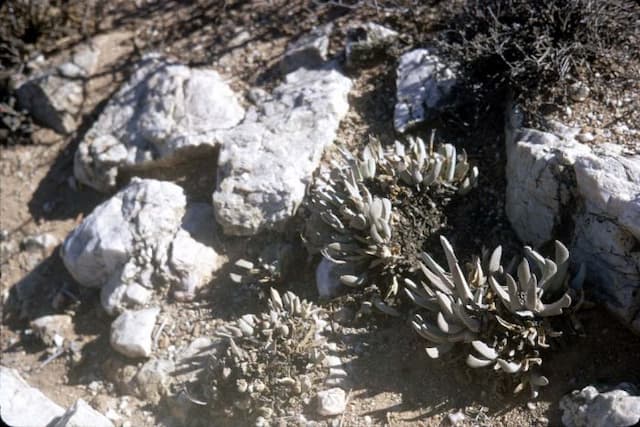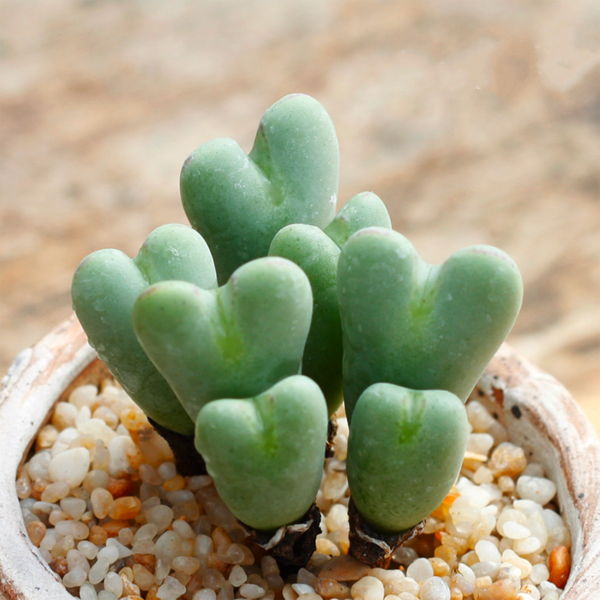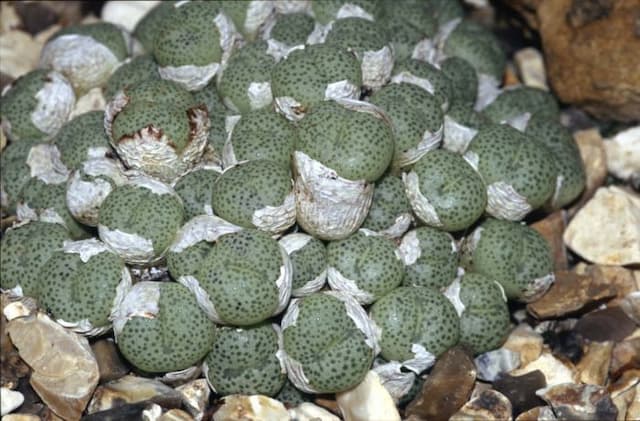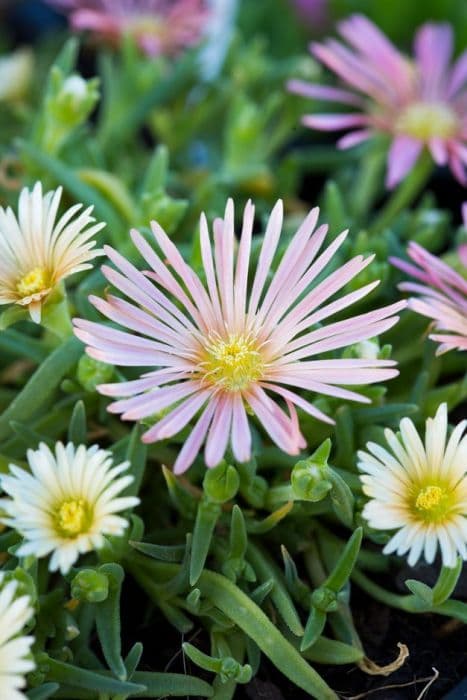Split Rock Pleiospilos nelii

ABOUT
Pleiospilos nelii, commonly known as the Split Rock plant, has a distinctive and fascinating appearance. The plant consists of a pair or several pairs of thick, fleshy leaves that are tightly compacted together, almost resembling a cleft stone or a cloven hoof. These leaves are usually grey-green or brownish-green and may have a hint of purple or reddish tones. The texture of the leaves is somewhat rugged with a dotted pattern of small, darker speckles scattered across them. The Split Rock plant produces conspicuous flowers that emerge from the center of the leaf pair. These blooms are daisy-like in shape, large, and can be strikingly vibrant, often in shades of yellow or orange. The blooms open in the late afternoon and close by early evening and can be quite long-lasting. The overall look of this plant often intrigues observers due to its mimicry of stones or pebbles, which is a survival adaptation for blending into its natural rocky environments.
About this plant
 Names
NamesFamily
Aizoaceae
Synonyms
Split Rock, Mimicry Plant, Cleft Stone, Living Rock, Royal Flush
Common names
Pleiospilos pedunculatus, Mesembryanthemum nelii
 Toxicity
ToxicityTo humans
The plant commonly known as Split Rock (Pleiospilos nelii) is not known for being toxic to humans. There are no widespread reports of poisoning or toxic reactions from ingesting or handling this succulent. However, as with any non-food plant, it is advisable not to ingest parts of it as it might cause discomfort or an allergic reaction in some individuals, even though such incidents are rare.
To pets
Split Rock (Pleiospilos nelii) does not typically appear on lists of plants that are poisonous to pets. It is generally considered to be non-toxic to cats and dogs. That said, ingestion of non-edible plant material can lead to gastrointestinal upset in pets, such as vomiting or diarrhea. Even though the risk of serious poisoning is low, it is always best to discourage pets from eating plants as individual animals might have variable sensitivities.
 Characteristics
CharacteristicsLife cycle
Perennials
Foliage type
Evergreen
Color of leaves
Green
Flower color
Yellow
Height
0.2 feet (6 cm)
Spread
0.2 feet (6 cm)
Plant type
Succulent
Hardiness zones
10
Native area
South Africa
Benefits
 General Benefits
General Benefits- Low Maintenance: Pleiospilos nelii, commonly known as "Split Rock," requires minimal watering and care, making it an ideal plant for busy individuals or those new to gardening.
- Drought Tolerant: As a succulent, Split Rock is highly drought-tolerant and can survive long periods without water, which is beneficial in arid climates or during water restrictions.
- Unique Aesthetic: The Split Rock plant adds an unusual and striking visual interest to any collection with its rock-like appearance and vibrant flower bloom.
- Indoor & Outdoor Versatility: It can be grown both indoors and outdoors, given the appropriate climate conditions, offering flexibility in placement and design within home landscaping.
- Non-Toxic: This plant is non-toxic, making it safe to keep around pets and children.
- Educational Interest: Cultivating Split Rock can provide an educational experience about succulent care and adaptation within arid environments.
- Small Space Friendly: Due to its compact size, the Split Rock succulent is suitable for those who have limited space but still wish to enjoy live plants in their living area.
 Medical Properties
Medical PropertiesThis plant is not used for medical purposes.
 Air-purifying Qualities
Air-purifying QualitiesThis plant is not specifically known for air purifying qualities.
 Other Uses
Other Uses- Pleiospilos nelii, commonly known as Split Rock, can be utilized as an educational tool for botany students, to study succulent plant adaptations like water storage in leaves and CAM photosynthesis.
- This plant is often employed in miniature gardening and fairy gardens due to its rock-like appearance, providing an aesthetically pleasing natural element.
- Split Rock can be used in living art installations, such as vertical gardens or green sculptures, because of its unique form and minimal need for soil.
- The plant serves as a conversation starter in home decor, introducing a touch of unusual natural beauty to interior spaces.
- Split Rock's ability to survive with indirect sunlight makes it suitable for terrariums, adding a low-maintenance piece of the desert to indoor environments.
- Pleiospilos nelii is used in photography to illustrate the diverse forms and survival strategies of plants, making it a subject for nature and macro photographers.
- As a model organism, Split Rock can be used in scientific studies on drought tolerance and desert plant survival mechanisms.
- Its unique, stone-like appearance is often used in thematic gardens, such as rock or zen gardens, to support the landscape's aesthetic without the need for frequent watering.
- Split Rock is utilized in craft projects like creating plant-based jewelry or decorations, where dried leaves are used for their texture and form.
- It can act as a natural barrier or ground cover in outdoor succulent gardens, helping to prevent soil erosion with its compact growth habit.
Interesting Facts
 Feng Shui
Feng ShuiThe Split Rock plant is not used in Feng Shui practice.
 Zodiac Sign Compitability
Zodiac Sign CompitabilityThe Split Rock plant is not used in astrology practice.
 Plant Symbolism
Plant Symbolism- Resilience: Pleiospilos nelii, commonly known as Split Rock, demonstrates an incredible ability to survive in harsh conditions, symbolizing one's capability to endure tough times and adapt to challenges.
- Adaptability: Split Rock has a remarkable capacity to store water and adapt to its desert environment, representing flexibility and the ability to thrive in various situations.
- Self-Sufficiency: The plant's succulent nature and low maintenance needs reflect the quality of being self-reliant and independent.
- Patience: As a slow-growing plant, Split Rock embodies patience and the understanding that some things take time to develop and flourish.
- Conservation: Split Rock's water-preserving qualities emphasize the importance of conservation and careful use of resources.
 Water
WaterThe Split Rock, or Pleiospilos nelii, requires minimal watering since it is a succulent plant adapting to arid conditions. During the growing season in spring and autumn, water once every 3 to 4 weeks, providing enough water to soak the soil, then allow it to dry out completely before watering again. This may equate to roughly 8-10 ounces depending on the size of the pot and soil mix. In winter, drastically reduce watering to once every other month as the plant goes dormant. Overwatering can be detrimental, leading to root rot, so it's crucial to err on the side of under-watering.
 Light
LightThe Split Rock plant thrives best in bright, indirect sunlight. An ideal location would be a south or west-facing windowsill where it can receive at least four to six hours of sunlight daily. However, it should be shielded from the intense midday sun to prevent sunburn on its leaves. Strong but filtered light will keep the plant healthy and encourage the vibrant colors to emerge in its foliage.
 Temperature
TemperatureSplit Rock prefers temperatures ranging from 50°F to 80°F, which makes it suitable for indoor environments. These plants can survive brief temperature extremes down to 40°F and up to 90°F but prolonged exposure outside this range can be harmful. The ideal temperature range is between 60°F and 70°F for optimal growth and flowering. Remember to protect your Split Rock from drafts and sudden temperature fluctuations.
 Pruning
PruningPruning the Split Rock plant is typically unnecessary as the plant naturally manages its old leaves, with new growth consuming the older, shriveled leaves. However, if dead or damaged leaves occur, they can be gently removed to tidy the plant and prevent potential rot. The best time for any necessary pruning is during the active growth period in spring or early autumn.
 Cleaning
CleaningAs needed
 Soil
SoilSplit Rock (Pleiospilos nelii) thrives in a well-draining soil mix consisting of 50% mineral grit such as coarse sand, perlite, or pumice mixed with 50% potting soil. It prefers a slightly acidic to neutral pH range of 6.0 to 7.5.
 Repotting
RepottingSplit Rock (Pleiospilos nelii) requires repotting infrequently, typically once every 2 to 4 years, as it prefers to be root-bound and grows slowly.
 Humidity & Misting
Humidity & MistingSplit Rock (Pleiospilos nelii) prefers low to moderate humidity levels and can tolerate dry air conditions typical of arid and semi-arid environments.
 Suitable locations
Suitable locationsIndoor
Place Split Rock near a sunny window and water sparingly.
Outdoor
Provide bright, filtered light and protect from extreme weather.
Hardiness zone
9-11 USDA
 Life cycle
Life cycleCommonly known as "Split Rock," Pleiospilos nelii begins its life cycle as a seed, germinating in warm conditions with minimal water, mimicking its native arid environments. The seedling slowly matures, forming a pair of succulent leaves that are thick and fleshy, adapted to store water. As the plant grows, the old pair of leaves is reabsorbed to give way to a new pair, with the plant seldom having more than two pairs of leaves at a time. Split Rock flowers in the fall or early winter, producing bright, daisy-like flowers that open in the afternoon and close at night. After pollination, the plant sets seed within a fruit that dries and opens, releasing seeds for dispersal. Throughout its life, Pleiospilos nelii undergoes periods of dormancy, mainly in extreme hot or cold seasons, requiring little to no water during these times.
 Propogation
PropogationPropogation time
Spring to Summer
The best time to propagate a Split Rock plant, or Pleiospilos nelii, is during the warmer months when the plant is not in its dormant winter phase. The most popular method of propagation for Split Rock is through seeds. The process involves sowing the seeds in a well-draining cactus mix, barely covering them with the substrate. Place the container in a warm area with bright, indirect sunlight and maintain a consistent temperature of about 70°F (21°C). Water sparingly, just enough to keep the substrate slightly moist until germination occurs, which typically is within a few weeks. Once the seedlings are large enough to handle, they can be transplanted into individual pots. Care should be taken not to over-water, as the young plants are susceptible to rot.
